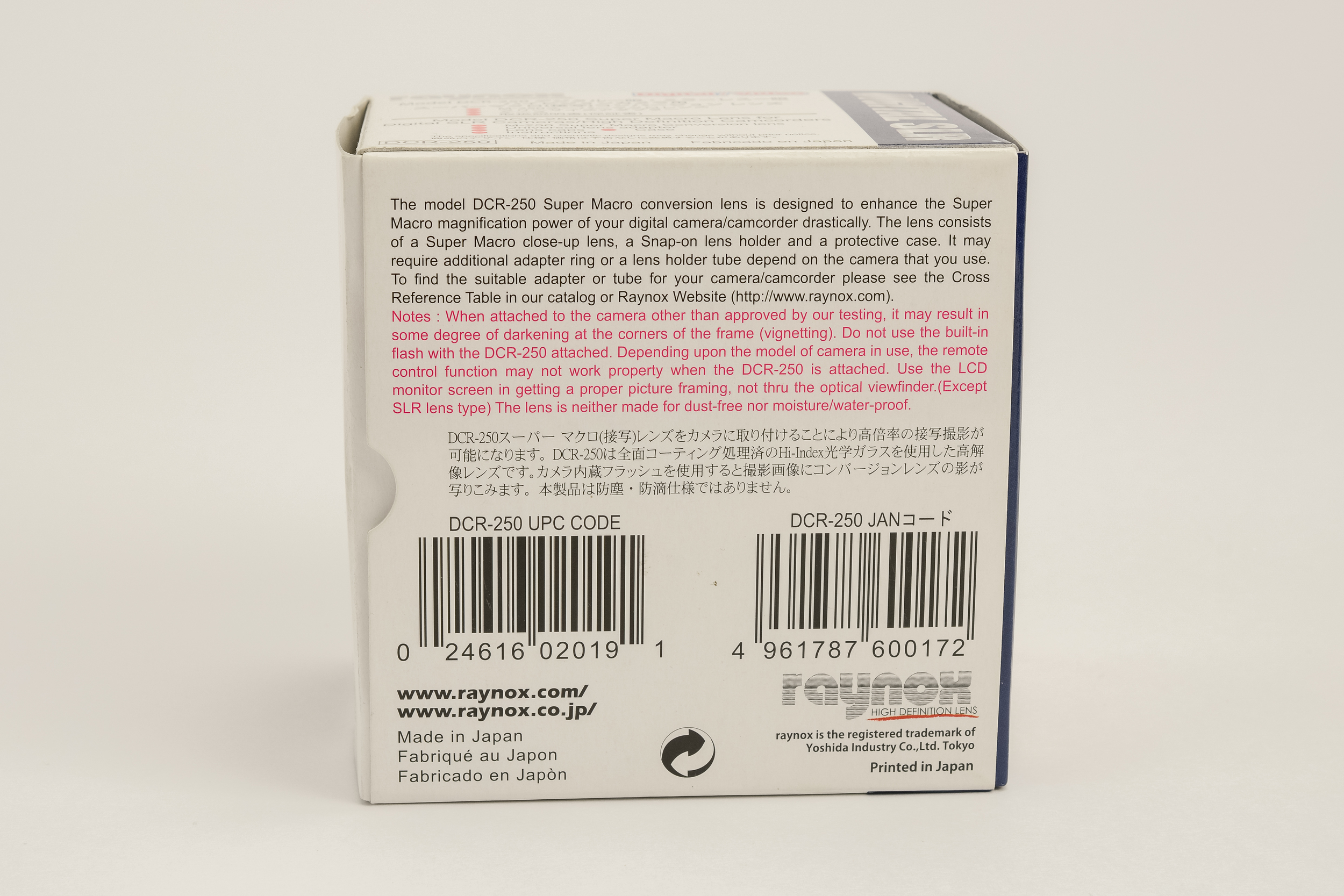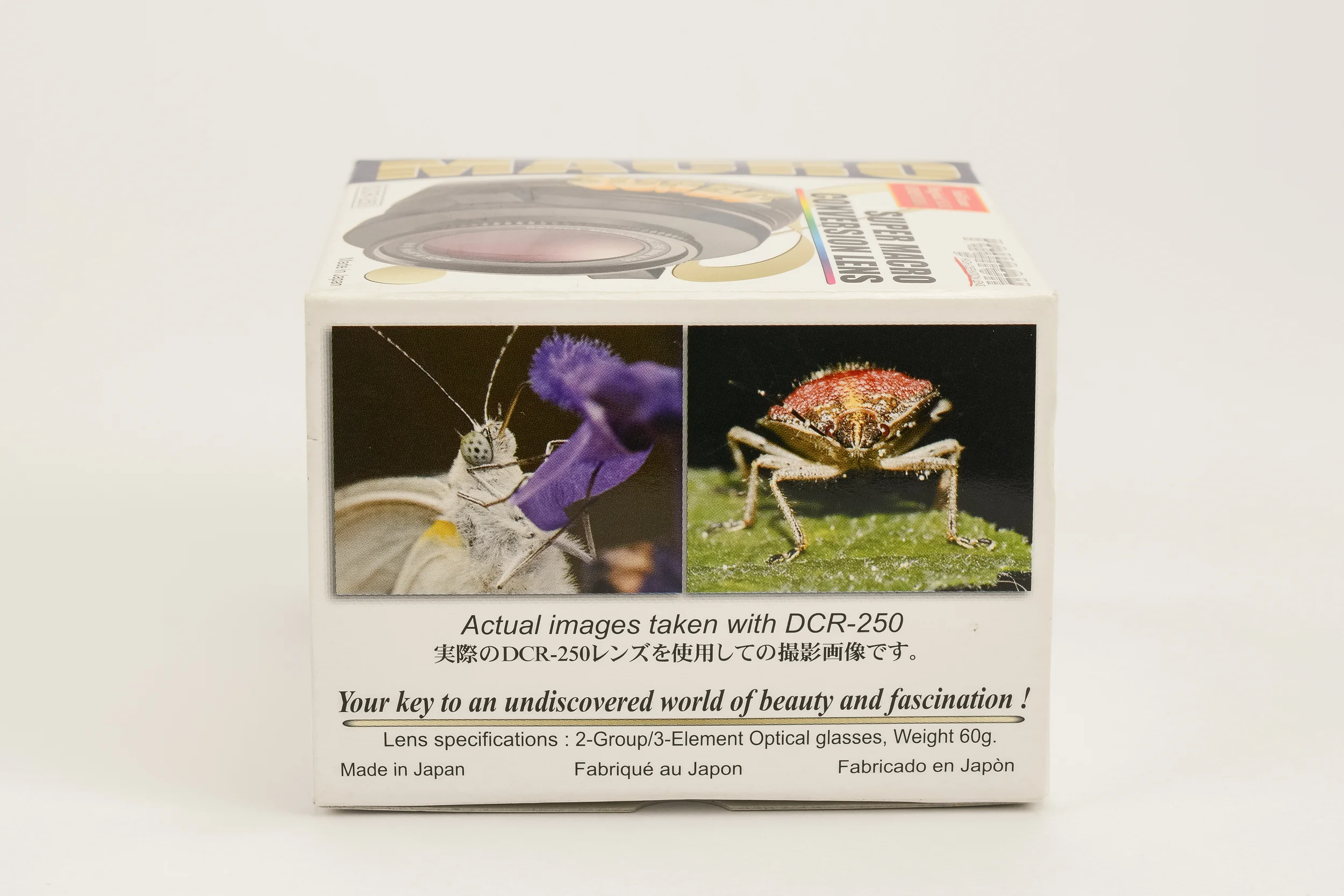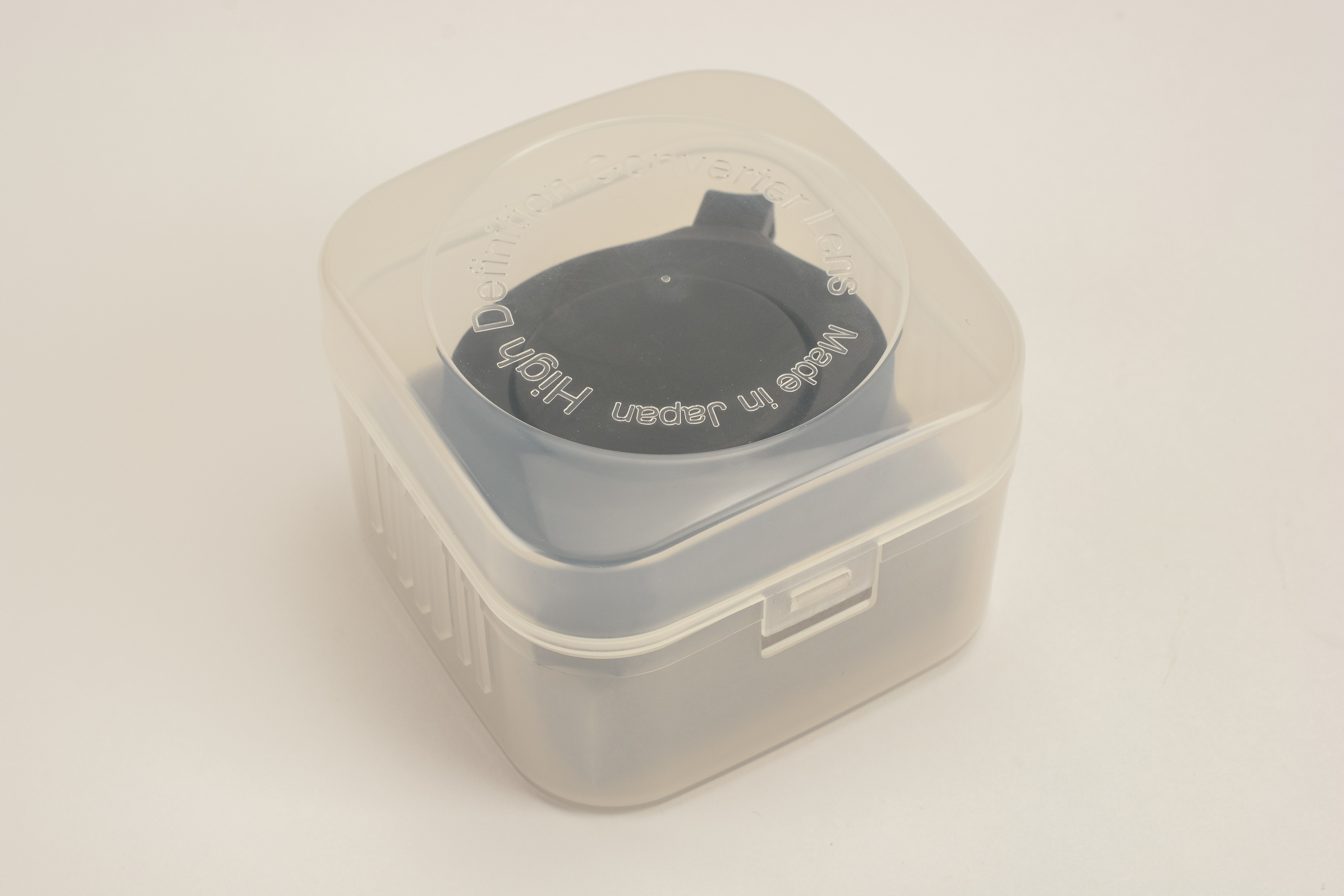The Raynox DCR-250 provides a low-cost solution to convert standard telephoto lens into flexible and affordable macro lens. I've been wanting to purchase and test this lens for months (why did I wait?).
Raynox (www.raynox.co.jp) is a unique, Japanese manufacturer of video and photography high-definition conversion lens. Raynox's product line includes telephoto, wide-angle, fish-eye, macro conversion lens and accessories. Raynox macro conversion lens come in five variations and diopters: 5/3/2, 4.8, 8, 25 and 32 diopter. Before you freak out, wait. I know most of us avoid filter-type conversion lenses like the plague - so why try the DCR-250? Keep reading. You might also be asking yourself "Why write a review on the Raynox DCR-250? It not new?" After searching the internet for reviews and not finding any in-depth review, I wanted to provide a deeper review of the conversion lens for the serious macro-photographer. This is not just an affordable filter for the beginner, but a useful tool for true macro photography.
If you expect to be impressed when you receive your Raynox package from UPS - you are going to have to wait. Through the eyes of a designer, the packaging looks like it is straight our of early 1980's (during the dawn of desktop publishing.) Raynox - please feel free to reach out me. Maybe we can swap some gear for graphic design consulting work. While difficult to open and snap closed, the DCR-250 does come with a sturdy plastic storage case.
What's Inside
- Raynox Microscopic Lens Model M-250
- Front and Rear Lens Caps
- Snap-On Universal Adapter for lens 52-67mm
- Storage case with protective foam insert
The lens features a high-quality 2-group/3-element construction - resulting in an 8-diopter magnification rating, weighing 2.1 ounces. You immediately realize this is not some cheap magnification filter - Raynox features quality glass optics. The front filter thread is 49mm and the mounting thread is 43mm (Note: Remember this measurement, it will be very important later). Someone from Raynox will need to explain why the lens is sold as the DCR-250 and the lens says "Model M-250"?
Lens caps
The cheap, soft-plastic lens caps that are supplied with the Raynox DCR-250 are almost impossible to remove. Honestly, while writing this review, I just ordered a 49mm lens cap on Amazon for only $1.88.
Snap-On Universal Adapter
The adapter that comes with the lens is my least favorite part of the product. The suggested installation process is easy: the 43mm male thread easily screws into the front of the adapter. The adapter features two spring-loaded catches that adapt the filter to lens between 52-67mm - gripping the filter-thread on most lenses. The adapter presented several issues. First, my Nikon Nikkor 80-200mm lens has a filter size of 77mm. This quickly proved the filter doesn't fit larger full-frame lenses. Second, the spring action makes it very difficult to make sure that the filter is centered on smaller lens like my 105mm lens. But there is an easy and affordable solution...
The solution is an affordable set of step-down ring filters. I purchased the XCSource 20-piece Step-Up/Step-Down Ring Filter ($15.99 on Amazon - affiliate link). While I didn't need all the sizes or the Step-Up rings, this looked to be the most affordable way to solve several problems with the Snap-On Universal Adapter. Combining several of the rings, you can quickly create an adapter that perfectly fits your exact lens - in my case steping down from 77mm. Remember that measurement earlier, you'll need a set of step-down rings that include a 43mm adapter to fit the male mounting thread. Also, don't be fooled. You do not have to screw them together into some crazy looking pyramid like the advertisements show. By reversing ever-other ring, you can create an adapter as narrow as the original Snap-On Universal Adapter.
Secondly, this method keeps the DCR-250 perfectly centered in your lens. I'm not an physicist, but I would think keeping the optics centered and parallel would be very important to the image quality. And third, the connection alleviates any concern of catching the adapter arms on your camera bag, strap or clothes; and accidentally having the filter pop off and land in the middle of the trail. As I proof-read this I feel like you're saying "What a pain in the...", but now what you have is a great little piece of glass securely attached to your favorite lens. Time to take some pictures.
Advantages
There are four main types of magnification for macro-photography: dedicated macro lens, extension tubes, lens-reversal, and conversion filters. The Raynox DCR-250 offers some great advantages over other forms of magnification. A dedicated macro lens can be expensive and generally offer a fixed focal length (Nikon 105mm f/2.8 $699; Nikon 200mm f/4 $1,399; Laowa 60mm f/2.8 $399, Tamron 90mm f/2.8 $499; Sigma 105mm f/2.8 $669.) For about $75 you can have a Raynox DCR-250, step-down rings and lens caps.
Extension tubes are also an affordable way to increase magnification. Unfortunately many extension tubes are not fully compatible with the electronics in modern lens and camera bodies. The Raynox DCR-250 plays very nicely with your camera, has limited impact on the EXIF data of your photos, with no impact to f/stop reading, or shutter speed; and depending on the camera or lens, you can also maintain auto-focus (which honestly isn't very useful in macro-photography.) Most extension tubes (and the Laowa lens) also require stepped-down focus (focusing in the dark) which can prove very difficult without a modeling light.
Focal distance. This is the main reason I wanted to test the Raynox DCR-250. I primarily have used a reversed 50mm lens with extension tubes for macro-photography and have been very happy with the results. But, by using a reversed lens, the focal distance is very short. Comparing two similar magnification levels, the focal distance of a Nikkor 50mm f/1.4 with 27.5mm extension tube is 3.0 inches, while the focal distance at 200mm on the Nikon AF-S Nikkor 80-200mm 1:2.8 D with Raynox filter is 6.1 inches. While three inches doesn't sound like much, when you're dealing with very sketchy insects, the further away the better. Ever try to get close to a dragonfly or butterfly? Those eyes can see you coming.
That brings us to conversion lens. Yes, usually just mentioning the words in front of any serious photographer result in a uncontrollable, painful contortion of their facial muscles. Raynox proves this doesn't have to be the case. Mounting the Raynox DCR-250 on a telephoto lens the Nikkor 80-200mm, I also preserve the advantage of utilizing the zoom. With a fixed-focus reversed lens, you have to swap extension tubes to change your magnification factor.
Watch Outs
Vignetting. I'm not that worried about the vignetting - the whole point for this conversion lens for me is magnification and focal distance. On smaller kit lens, you will notice slight vignetting in the corners - even less noticeable on a DX body, understandably. On the larger Nikkor 80-200mm the vignetting can be quite extreme, especially at the shorter zoom distances (caused by the step-down ring or Snap-On Universal Adapter needed for mounting.)
Magnification. Notice I haven't once referred to a multiplication 'x' factor. The magnification from the Raynox DCR-250 is entirely dependent on what lens you use. I first tested the DCR-250 on a Micro-Nikkor 40mm and the magnification was almost negligible (approximately 25% enlargement.) Attached to a 105mm lens, the Raynox steps up to the game delivering 425% enlargement at the closest focal distance. So remember - the longer the telephoto lens, the greater magnification results from the DCR-250.
As mentioned earlier, the lens caps and Snap-On Universal Adapter can be problematic. The lens caps are difficult to remove. The Snap-On Universal Adapter is difficult to center on your lens and could be prone to accidentally popping off your lens.
Next Steps
This Spring, I'll be fully testing out the Raynox DCR-250, putting it through its paces. As I continue to test and practice with the conversion lens, I'll add sample photographs to this review. I also look forward to testing DCR-250 on the Sigma 105mm and the Laowa 60mm macro lenses. Here are a couple wonderful images from the talented Pascal Gaudette utilizing the Raynox DCR-250 :
Check out more of Pascal Gaudette's work on Flickr.
UPDATE: April 29, 2017: Below are several images from the Nikon D750, with the Tamron SP 90mm F/2.8 MACRO VC, Raynox DCR-250 and KX-800 Twin Light Macro Flash. Absolutely pleased with the results.
Recommendation
A little early for a definitive answer, but even the initial results from the Raynox DCR-250 are very impressive. UPDATE April 2017: Changing my recommendation to a strong BUY recommendation. I've been very impressed with the Raynox DRC-250. The best macro photography accessory I've bought for the price. A great buy on Amazon (affiliate link: currently $66.95 on Amazon). There are not many lenses or photography accessories for this price that provide such impressive results. Don't forget to get the Step-Down rings for secure installation - only $15.99 on Amazon, and a good 49mm lens cap.
- written by Peter Bartlett



